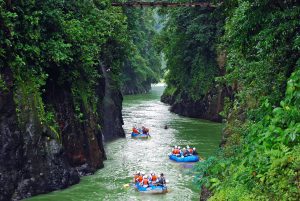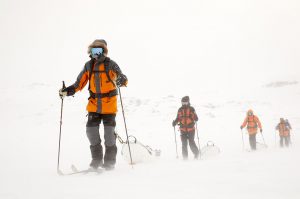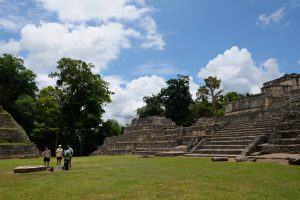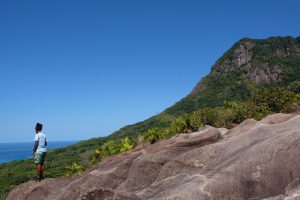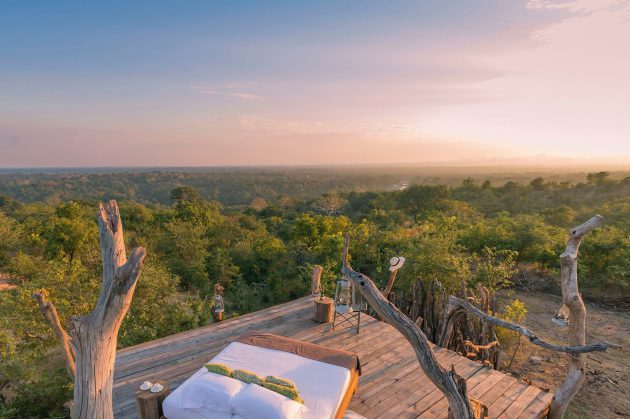
Malawi is in the business of revival, be it creating Southern Africa’s newest safari destination by repopulating its epic wildernesses, opening a heritage hotel as a window to the grandeur of the colonial age or ushering travellers to its lakeside beaches
View article online at nationalgeographic.com
Night in the African bush falls like a portcullis. Dusk is a leisurely curtain call of deep reds and glowing umber but then, as if a switch were flicked, the light exits stage west, sucking every drop of colour with it.
It’s in this sudden blackness that I’m left blinking and shivering despite the heat, standing alone on the flat roof of a solitary cabin in the middle of Majete Game Reserve, watching the headlights of the 4×4 that just dropped me off disappear into the night.
The cabin is an outpost of the luxurious Mkulumadzi Lodge some miles away. There’s a king-size bed in the centre of the rooftop, enclosed in a giant teardrop of mosquito net. I patrol around it, dim lantern in one hand and emergency horn clutched in the other, trying to make sense of the primordial darkness. Gradually, shadowy masses around the hut untangle into distinct outlines of gnarled mopane trees and the limbs of euphorbia cacti curling skywards like candelabra. I try to identify unfamiliar noises: the rush of a river barrelling southwards from Lake Malawi; the beating wings of bats overhead; the crackle and shiver of creatures moving through the desiccated undergrowth. For the first time in a safari park, I pray the Big Five stay well away.
Above me, a shooting star drops lazily through the heavens. This is the spectacle I’ve been left here to enjoy: from horizon to horizon, the firmament is ablaze. It’s spellbinding. I feel like I’m on the edge of the Earth looking into the cosmos. The Milky Way arcs over the bed. The low crescent moon is a glowing stud in my starry headboard. Planets twinkle distinctly. It’s as if I’ve got my own, incredibly colourful orrery: there’s the topaz glow of Mercury, the diamond of Venus, the ruby of Mars. I switch off the lantern and let the starlight brighten. And this is how I spend my first night in Malawi: watched over by the planets and stars, and wrapped up in the heavy cloak of a benign, wild, spring night. It’s magical.
Sticking it out alone on an experience usually offered to couples has the unintended consequence of impressing my safari guide, Mustafa. “You didn’t get scared? I thought for sure you’d call us back!” he laughs as we take morning tea in the bush besides the Mkulumadzi River. Mustafa radiates goodwill and chuckles like it’s going out of fashion. They don’t call the country ‘The Warm Heart of Africa’ for nothing. The natural kingdom, in particular, provides a constant source of joy for him. And it’s infectious. Driving earlier that morning through tall forests, where quartz boulders shimmer like disco balls, we shared gleeful squeals at scuttling warthogs, uproarious belly laughs at rutting impala, and giggles of astonishment at a herd of elephants.
We kick off our boots and paddle in the shallows, just another pair of animals out for a cooling dip. The sandy bank was decorated overnight by countless paws, hooves and talons — a testament to the thriving ecosystem that’s been painstakingly nurtured back to health from an out-and-out poaching crisis. I spot the large impressions of elephant feet; the sand has perfectly preserved the cracks in its skin, which appear like raised tributaries on a map. A park ranger, Ado, wearing a smart, navy blue uniform and carrying a very powerful .458-calibre rifle, stands sentry on the shore. “I feel so proud of what we’ve achieved here,” he tells me later in an unguarded moment as we hike to see the confluence of the Shire and Mkulumadzi Rivers. We watch the two raging currents, each with its own colour and texture, smash into each other and vie for dominance as gravity pulls them downstream. “Things could have gone another way entirely.”
Before African Parks took over the administration of Majete in 2003, poaching had decimated the park. The non-profit organisation has a reputation for rejuvenating floundering parks (including four in Malawi alone) to the benefit of local communities, but with only a handful of antelope remaining inside Majete’s 270sq mile perimeter, and tourism all but dead, the odds here were stacked. Gradually, however, relations with the surrounding villages were improved; rangers like Ado were given military-style training; and Africa’s most iconic animals were successfully reintroduced. Rhinos and elephants at first, and then a dozen more species including leopards and lions. For a country once known for being among the world’s least-developed, it’s a fantastic success story that’s seen it become a conservation leader in Africa. Now, Majete is Malawi’s first, and so far, only Big Five park — a responsibility Ado takes seriously: “We’ve never lost a single rhino or elephant to poaching, not in 15 years. Things are changing in Malawi.”
A few days later I head to Liwonde National Park, which has recently been given a second chance, too. “We have orange snow at the moment,” Steegan, the manager of Kuthengo Camp, observes with a note of apology when I step off the jetty and accept an iced tea from her under the billowing boughs of a fever tree. Odd, spherical flower-puffs eddy around us, caught in the breeze. Bushbuck graze at the river’s edge. The peace is broken only by bird cries. Somehow, amid all this beauty, I’m the only guest. Kuthengo (meaning ‘in the bush’ in the national language of Chichewa) became Liwonde’s second safari operation when it opened in 2018 with a handful of luxury tents smack-bang on the fertile Shire floodplain. “It’s pronounced ‘Shir-ree,’” head guide, Stanley, corrects me gently as we head back out on the water for safari.
Chugging along the placid Shire with swallows flitting around our boat and the sunlight flickering behind borassus palms, it’s hard to imagine Liwonde in disharmony. Stanley details the mammoth restoration projects undertaken since African Parks assumed management in 2015. One was to dig out 36,000 wire poaching snares. Another was to tackle elephant overpopulation, which conservationists achieved in a historic feat by tranquillising and relocating 336 to a reserve in the country’s north.
From the boat, views span across reeds dotted with birds as bright as baubles and long-legged waders stalking the shallows. “As many as a thousand crocodiles live in every mile of this river,” Stanley says, with a warning look to the hand I’ve got trailing in the water. Hippos snort disgruntled greetings as we pass, twiddling their terracotta ears and eying the boat with unconcealed menace. We spot elephants on the shoreline — around 60 of them, with calves — breaking from the tree line and heading our way for a drink. Zebras, too, among the tall grass, and reedbuck and waterbuck and sable, all with young. There’s new life everywhere.
The Shire River was dubbed ‘God’s highway’ by Scottish explorer and missionary Dr David Livingstone when he reached these parts in 1859. He was searching for a river route that could open up the heart of Africa; but discovered to his disappointment that, as the Shire flows out of Lake Malawi towards the Zambezi in Mozambique, it drops 1,300ft through a series of impassable falls. Stanley takes me to see the park’s oldest baobab tree where Livingstone pitched camp. It’s a vast cathedral of a tree with a hollow trunk, buttressed on one side by the knitted branches of an equally ancient fig tree.
We climb inside the tree, standing where Livingstone once stood. His expedition, during which he ‘discovered’ Lake Malawi, ushered in colonialism: Britain staked a claim to Nyasaland, as Malawi was called, in 1891. After achieving full independence in 1964, the country stagnated for three decades under the dictatorship of Hastings Banda. Malawi’s eventual return to democracy in 1994 did little to elevate its reputation: until very recently, regional instability and economic turmoil put tourists off. It’s a relief to climb out of the dark baobab and be reminded of how much brighter the future is looking.
For my last few nights in the park, I move to Mvuu Lodge, which for 25 years was the only camp in the whole of Liwonde. It’s there I meet a guide, David, who promises to introduce me to the park’s newest residents: lions, released in 2018, and cheetahs, reintroduced the year before. “The impala didn’t get a vote on it,” he jokes darkly. The park is focused on restoring poached-out populations, with wild dog and giraffe next on the list, and David tells me tourism is slowly increasing as travellers like me come to witness the revival.
We set off early, before dawn has broken, but still need to move fast and cover a lot of ground if we’re going to catch a big cat out hunting. David hangs out of the side of the vehicle while driving, scouring the dirt for tracks, but it’s the circling vultures that give us our first lead. We approach and find the carcass of an impala being plucked apart by scavengers. “It’s moved on. But it must be close.”
David’s right: as we round a thorny thicket decorated with the nests of weaver birds, I catch sight of something red among the yellow and dun of the plain. My brain is still scrambling to interpret the scene when David slams on the brakes. It’s a cheetah with a fresh kill. It releases the bushbuck’s neck from its blood-spattered jaws and stares at us. I see the distinctive black tear lines on its face, its neat spots, the creamy fur on its belly, the way it blends in with its surroundings. “We just missed the action!” David laments, spotting the rest of the bushbuck herd cantering away. Still, when you consider that before this cheetah’s arrival, Malawi had been completely devoid of the predator for 20 years, we’re here at just the right time.
Rare species
Driving southeast on dusty roads, dodging goats and people, mud-brick villages built on parched red earth peter out and the terrain rises into lush, electric-green tea plantations. In the heart of these highlands, on the slopes of Mount Thyolo, there exists a rare monument to the grandeur — and pioneering spirit — of Malawi’s colonial era. As with the national parks, at Satemwa Tea Estate there’s a move to salvage Malawi’s natural and cultural riches for posterity.
“There was a storm last night and it’s taking some time for the power to come back,” Tracy, the manager of Huntingdon House, explains as we tour the manor built by Maclean Kay at the heart of the plantation. “All part of the pioneering experience!” she adds cheerily. It’s dusk, and the housekeeper is lighting tall candles in the dining room. Light glints on the polished Edwardian furniture and mahogany bookshelves and catches the silverware on the tables. Through large windows that open onto a veranda set with armchairs, children are playing croquet on a lawn. Tracy straightens a painting on the wall, and for a moment this could be an old country house in Britain. But then a gecko shoots up the wall from behind it. “Let me introduce you to our bats,” she suggests casually, leading me through a maze of doors to stand under the eaves of a secret patio. “They’re a rare species.”
The romantic manor, wrapped in vines and creepers, has been a central character in the Kay family saga since its construction in 1935. It was here that Chip Kay, Maclean’s now-elderly son, grew up and raised his own family. In 2009, in a move to share Malawi’s colonial heritage with the public, five bedrooms were opened up to guests. It’s full of charming quirks: a honeymoon suite in a chapel (“never consecrated,” Tracy assures me); roll-top tubs where bubble baths come with a dose of borehole silt; and a wi-fi connection best experienced with a drink and plenty of patience. With his handlebar moustache, Chip himself is one of Huntingdon’s historic attractions — another rare breed in these parts — but his poor health keeps me from hearing his legendary stories.
So instead of the past, I look to the present and the future of Satemwa. In the morning, a wild breeze blows up from the tea terraces, over the manicured beds of dusky hydrangeas and explores the house, troubling the drapes and tugging on my sleeve to get outside and explore. Around 10,000 rolling acres of tea and coffee and blue gum trees await. On a sweaty mountain bike ride, I discover the joys of eating coffee beans straight from the bush and of drinking tea on the factory floor with the tasters. I stop and chat with a group of female pickers wearing traditional chitenje (patterned cloth) wrap skirts, who find my presence so alien and entertaining that work is halted to indulge in a rib-splitting fit of giggles.
Huntingdon may have its roots in a sophisticated era of silver service suppers and sundowners, but it’s also a place to hitchhike up dirt tracks in the back of a pick-up to picnic spots, or to get your hands grubby. Besides exporting coffees and teas around the world and investing in the lives of its 1,500 workers, Satemwa is committed to restoring Malawi’s forests, which are shrinking as a result of unregulated farming. This is why I find myself wielding a rustic hoe for an afternoon, digging ditches then smoothing the earth around mahogany saplings. Nothing but warm smiles greet me as I traipse red clods of earth across Huntingdon’s colonial hearth.
Lake of stars
If my first week set me up with an impression of pristine landscapes and a sense of a country emerging lighter and more hopeful from a weighty past, then it’s down at the lakeshore that I come face to face with the energy of modern Malawi. The annual Lake of Stars Festival is back after a hiatus, and down on the beach I’m dancing barefoot to live bands among a mix of fashionable urbanites from Blantyre and Lilongwe, local beach bums and aid workers on furlough. “This is the biggest party anywhere in Africa right now!” the lead singer of a Kenyan boy band yells to a crowd of thousands. Behind the main stage, upstaging all the acts, Lake Malawi stretches to the horizon.
This is landlocked Malawi’s greatest treasure. Measuring 360 miles north to south, and filling a deep trench of the Great Rift Valley, Lake Malawi is one of the planet’s most fascinating freshwater ecosystems. Hundreds of unique fish species call it home, and the water is so clear and calm that sometimes it feels like swimming in an aquarium. It’s an absorbing masterpiece of vivid hues that’s positively hypnotic, especially at sunset when the waves shimmer gold and pink.
When the festival wraps up and the crowds disperse, I follow the shore south to the sucrose beaches of Cape Maclear in Lake Malawi National Park. It’s the type of easy-going paradise that ensnares wandering backpackers: lazy days become lazy weeks, whiled away in lakefront bars learning strategies of the board game bao or browsing village stalls for carved souvenirs. “No one seems to use time here,” I overhear a new arrival say. “It’s only ‘yesterday’, ‘today’ or ‘tomorrow’.” But I can’t linger: I still have my eye on the horizon.
Early the next morning, I board an antique fishing boat in Cape Maclear. It chugs slowly out into the lake until the mainland becomes a hazy shimmer and a tiny, rocky island rears into view. Below its crown of trees are five thatched bamboo cabins, set above a cove and scattered among colossal boulders. This is Mumbo Island, an off-grid eco-camp at the heart of the national park and, as luck would have it, I’m the only guest again. I throw myself into the role of Robinson Crusoe. I take a kayak out and circle the island, spotting otters among the rocks, then tip myself overboard to snorkel through a kaleidoscope of cichlid fish. In the cool of late afternoon, I follow a treasure map through the island’s sun-dappled woodlands to find secret caves and viewpoints and then, as the sun sinks, I sit on the island’s sandy beach, which is empty except for a pair of large, lazing monitor lizards.
That night, I struggle to sleep, and when I step out onto the deck of my cabin for some fresh air, I have to rub my eyes. There are distant pinpricks of light on the surface of the dark lake, as if entire constellations have fallen from the night sky into the water and continued to blaze. I realise it’s the same scene Dr Livingstone saw when he visited in 1859; the reason he described it as the ‘lake of stars’. Each orb is a fisherman working by the glow of a lantern hung from the prow of their boat, the way they’ve done for centuries. I curl up in my hammock and enjoy the moment, suspended between the ancient lights of the heavens and their twinkling echoes on the water. And this is how I spend my last night in Malawi, much like I did my first: alone in the wilderness, surrounded by stars.
Essentials
Getting there & around
Ethiopian Airlines flies from Heathrow to Blantyre and Lilongwe via Addis Ababa, while South African Airways flies to both destinations via Johannesburg.
Average flight time: 16h.
A number of motorways in Malawi are under construction, meaning some sections are wide, paved and modern while some are dirt-track diversions. Organise private taxi transfers through your hotel or operator or opt for public transport in the form of shared taxis or local minibuses (be wary of overcrowding though). Car hire is relatively expensive and can be arranged in Lilongwe or Blantyre.
When to go
Malawi has a tropical climate with three distinct seasons: April to August is temperate and dry with temperatures around the mid-20Cs (and some chilly nights in July and August); September and October are dry and prone to drought; and the hottest summer months (in the low 30Cs) of November to March see rainfall. The highland regions around Satemwa are always cooler than the Shire Valley’s national parks and the lakeside.
More info
Malawi (Bradt Travel Guides). RRP: £17.99
africanparks.org
lakeofstars.org
visitmalawi.mw
How to do it
Gane and Marshall’s ‘Southern Malawi Highlights’ includes visits to the Thyolo Tea Estates, Liwonde National Park, Majete Game Reserve and Lake Malawi. Price starts from £4,360 per person, based on two sharing. Includes 14 nights’ accommodation in hotels, lodges, camps and resorts on an all-inclusive or full-board basis, transfers, game viewing, national park fees and some watersports on Lake Malawi. Flights are additional.
Published in the May 2019 issue of National Geographic Traveller (UK)





